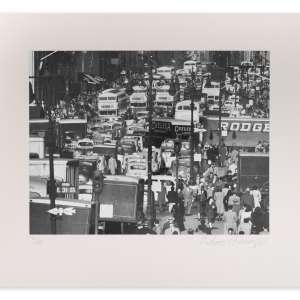Previous
Next




Andreas Feininger
Traffic on 5th Avenue, New York City, 1948
Silver gelatin print. Printed 1976
Image: 9 7/16 x 12 7/16 inches
Mount: 14 x 17 inches
Mount: 14 x 17 inches
Edition 9 of 100
Signed and editioned in pencil recto; titled and dated in pencil verso, titled, dated, and editioned in ink on label verso
Inquire
%3Cdiv%20class%3D%22artist%22%3E%3Cstrong%3EAndreas%20Feininger%3C/strong%3E%3C/div%3E%0A%3Cdiv%20class%3D%22title%22%3E%3Cem%3ETraffic%20on%205th%20Avenue%2C%20New%20York%20City%3C/em%3E%2C%201948%3C/div%3E%0A%3Cdiv%20class%3D%22signed_and_dated%22%3ESigned%20and%20editioned%20in%20pencil%20recto%3B%20titled%20and%20dated%20in%20pencil%20verso%2C%20titled%2C%20dated%2C%20and%20editioned%20in%20ink%20on%20label%20verso%3C/div%3E%0A%3Cdiv%20class%3D%22medium%22%3ESilver%20gelatin%20print.%20Printed%201976%3C/div%3E%0A%3Cdiv%20class%3D%22dimensions%22%3EImage%3A%209%207/16%20x%2012%207/16%20inches%3Cbr%20/%3E%0AMount%3A%2014%20x%2017%20inches%3C/div%3E%0A%3Cdiv%20class%3D%22edition_details%22%3EEdition%209%20of%20100%3C/div%3E
Andreas Feininger Biography
Working under the modus operandi, "What matters is not what you photograph, but why and how you photograph it,” Andreas Feininger was a pioneer both visually and technically. Although his body of work covered a wide range of subject matter, Feininger is perhaps most well known for his black and white architectural photographs as well as his assignments for LIFE Magazine. His experimentation with developing his own camera systems and lenses allowed him to create distortion-free images of architecture and landscapes in a groundbreaking way. This is perhaps best remembered in his LIFE Magazine photo “Route 66, Arizona” (1947) which conveyed the seemingly infinite length of the American landmark.
Born in Paris, France in 1906, Feininger was raised in Germany and went on to study at the Weimar Bauhaus. It was while studying architecture that Feininger picked up photography and began to capture the buildings that surrounded and inspired him. He continued to work as both architect and photographer in Germany until a changing political climate relocated him to Paris, where he worked in the studio of the famous architect Le Corbusier. A subsequent move to Stockholm led Feininger to establish a photographic firm specializing in architectural and industrial photography. At the onset of World War II in 1939, Feininger moved to New York City, where he joined the war effort as a photographer for the U.S. Office of War Information. From 1943 to 1962, Feininger worked for LIFE Magazine where he fully established his reputation as one of the most prolific photographers of his time.
In his lifetime, Feininger received numerous awards including the American Society of Media Photographers’ Robert Leavitt Award, its highest distinction. Today, his photographic archive is held at the Center for Creative Photography in Tucson. His photos are held in the permanent collections of prestigious institutions worldwide, including the George Eastman Museum in Rochester, NY, The Museum of Modern Art in New York, the National Gallery of Art, and London’s Victoria and Albert Museum.



